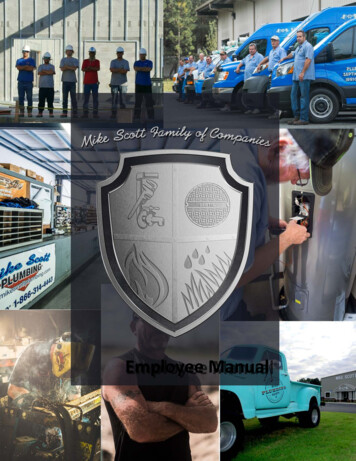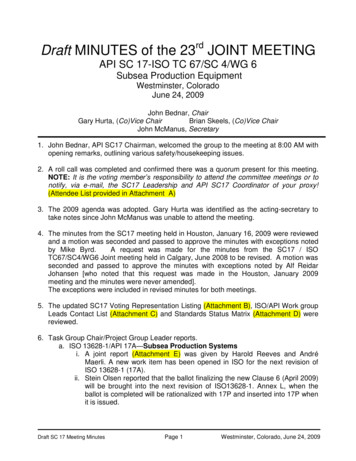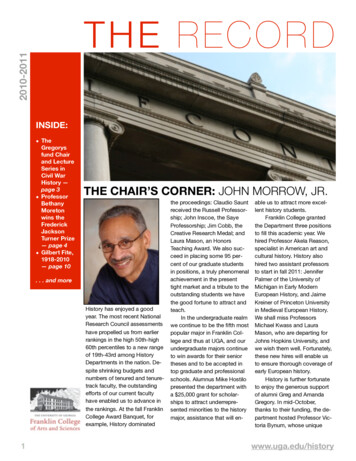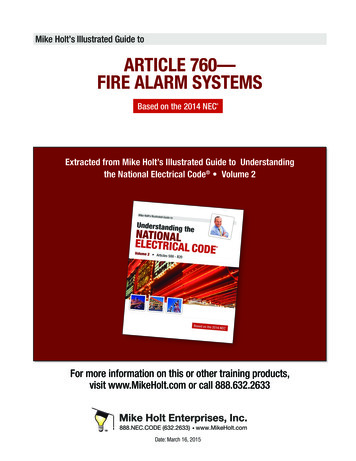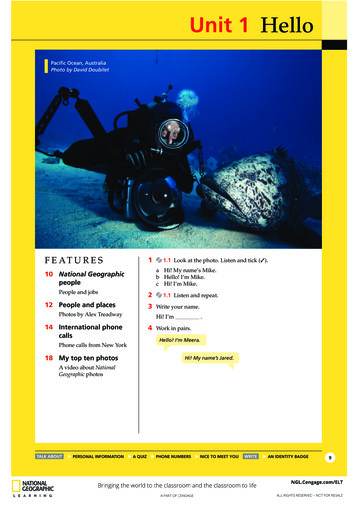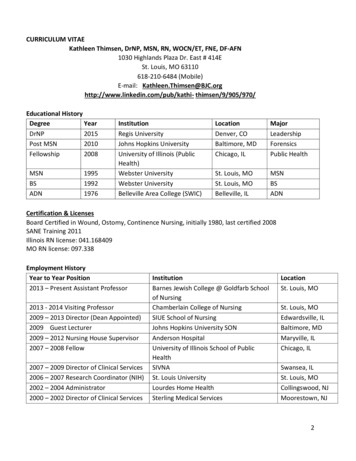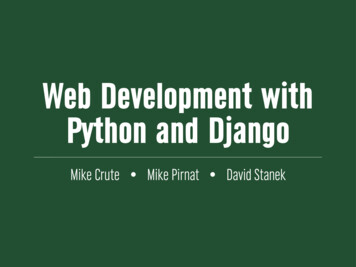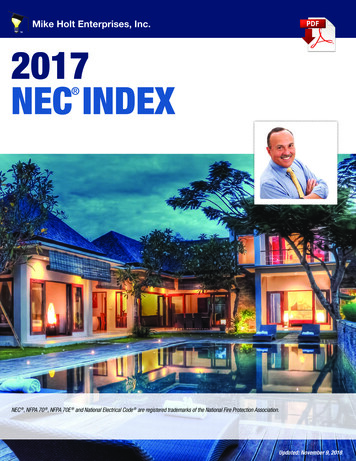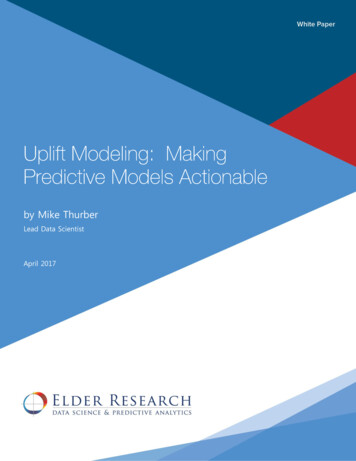
Transcription
by Mike ThurberLead Data ScientistApril 2017
Predictive Models vs. Prescriptive Uplift Models . 3Uplift is Not Directly Measurable . 4Estimating Uplift. 5Achieving a Return on Marketing Investment . 6Benefits of Uplift Analytics . 7About the Author . 7
Predictive models typically estimate the likelihood of future events, such as whether it willrain tomorrow or which customers are most likely to “churn” by cancelling their phonecontract. In the case of the weather, we do not expect to change it; we just want to knowhow to adapt. However, the goal for most use cases is to be more proactive; we want tounderstand what action to take to change the outcome in a favorable way. (See theexamples in Figure 1) In these cases prescriptive, not just predictive, analytics isrequired. The return on investment comes directly from knowing the impact of alternativetreatments. By knowing the impact of each treatment, resources can be targeted where theywill be most effective and withheld where they will have negligible effect or worse, have anegative effect. This great objective of data science, to intelligently drive day-to-daybusiness decisions based on data, is the purview of uplift modeling. This white paper willexplain what uplift modeling is and why it can be much better than directly modeling theoutcome.There are many applications of predictive modeling where the outcome is predicted asadvice only to a human decision maker, and no action is directly taken automatically fromthe model result. An example is workload prioritization. For example, in the telecomindustry we can predict which customers are most likely to churn (cancel their contracts).In healthcare we can predict which patients are most likely to recover. For universities orcharitable organizations, we can predict which prospective benefactors are most likely todonate.Sometimes this is sufficient. For example, if the outcome of our weather prediction is that itis likely to rain, we take an umbrella. Since we can’t change the weather we can only bebetter prepared for it.But where we can, we aim to influence the Use CaseTargeted Outcome Treatmentoutcome one way or another. Will a liveOutdoorsWeatherBring Umbrellaagent offering the phone customer aOffer Upgradecontract upgrade decrease their likelihood Phone Customer Not ChurnFigurePatient2. Uplift modelingRecover examples showingTreat targetedto churn? Will soliciting a fund sageprospect with a flyer in the mail improveDonateSolicittheir chances of making a donation? Will Donoroffering a moving bonus increase theProspectJoinInvitelikelihood that a desirable candidate willCandidateHire OnPay Moving Bonusaccept our employment offer? The mostInmateNot RelapseCoachcommon example where uplift modelingPSTD VeteranNot Self-harmCounselhas taken hold is in retail marketingGas wellNot Shut-inInsulatewhere the goal is to predict not theRetail Customer BuyOffer Salelikelihood of a customer buying, but whatFigure 1. Predictive modeling examplescan be done to increase the likelihood ofthem making a purchase.The salient knowledge sought is the impact of the treatment, not the estimate of theoutcome. For instance, would you rather spend campaign dollars trying to persuade yourmost loyal supporters (those with the highest probability of “buying”), or on the voters who
will be swayed the most by an additional engagement? Simply predicting the expectedoutcome is not sufficient to optimize your use of money and resources. A few elections agoI was determined to vote for a particular candidate, who meanwhile, kept filling mymailbox with campaign material. Even though my publicly available data should havedemonstrated that I was already a sure vote they could count on, they wasted many glossyflyers on me.1Uplift modeling is also known as incremental modeling, treatment effects modeling, true liftmodeling, or net modeling. Uplift is the increase in likelihood of the outcome with thetreatment as compared to the outcome without the treatment. We can’t observe thisdifference, or causal effect, directly, but must infer it from an experiment.Eric Siegel’s book Predictive Analytics: The Power to Predict Who Will Click, Buy, Lie, or Diedevotes a chapter with excellent case studies showing why it is important to have upliftmodeling in your data science tool kit and to use it appropriately. It is very helpful tovisualize a 2x2 matrix, as shown in Figure 2, with four categories of people (say) to beclassified, as: (a) Persuadable, (b) Sure Thing, (c) Do-Not-Disturb, and (d) Lost Cause asshown in figure 3.To promote a desired response we target the “a” population – those who are Persuadable.For all others, the treatment is wasteful or, for the Do-Not-Disturbs, it is actuallycounterproductive. Contacting the Do-Not-Disturbs may result in the customers acting in theexact opposite way that was intended – it can be perilous to “wake a sleeping dog”.Uplift modeling’s objective is to find Persuadables. Of course, uplift modeling can apply toany modeled outcome, human or not, such as the effect of fertilizer on crop yields orsending email messages in political campaigns. Again, where traditional predictivemodeling focuses on the outcome, uplift modeling focuses on the effectiveness of thetreatment. Then, you can target resources on the cases that are likely to be positivelyimpacted by the treatment.ResponseifTreatedNYDo-Not-Disturb Lost CausecdSure ThingbPersuadableaYNResponse if not treatedFigure 2. Uplift model matrix.
Consider a telecom example of trying to prevent customer churnas shown in figure 3. The treatment is to offer an upgrade to aOffer freeNo offercustomer who is a potential churner. To perform uplift analysis,upgrade400 random 1,600 control we conduct an experiment with 400 randomly selected testaccounts to whom we offer a free upgrade, and a control group oftest accountsaccounts1600 accounts that receive no offer. (It is common to have a larger8 churns160 churnscontrol group as it is less expensive). In this experiment, we record392 non1,440 nonchurnschurns8 churns in the group that received an offer, and 160 churns in thegroup that did not receive an offer. This means that there is a 2%RT: 2% churn RC: 10% churnchurn in the experimental group (RT) and a 10% churn in theU: Offer had -8% upliftcontrol group (RC). The offer has a -8% uplift (U):2,000 Potential ChurnersChurn Odds Ratio: 5.4Odds Ratio 99% CL:2.12 to 14.00Uplift 99% CL RC 10%:-5.0% to -9.2%Overall Uplift U RT – RC 2% - 10% -8%The uplift in this case is negative because we are trying to avoidthe target behavior rather than promote it.Figure 3. Telecom Upliftmodel example.For Uplift to be actionable in practice, we also need to know the treatment effect for eachindividual person uniquely, in addition to the general population. For example, myprevious volume of online shopping may indicate that I am more persuadable to click on aparticular advertisement than others in my same demographic group. Thus, we want tomodel how the attributes of a case impact the treatment uplift of that case. The way such amodel is created in practice is as follows:1) predict the outcome with the treatment applied (RTi in the telecom example),2) predict the outcome without the treatment applied (RCi in the telecom example),3) calculate the difference in the rates as the uplift (Ui RTi-RCi), and4) compute the upper and lower 95% confidence limits on Ui.Once these values are calculated, individuals can be allocated to the four quadrants of thetreatment effect matrix using these rules: If the confidence limits of the Incremental Uplift (Ui) includes zero, the treatmenteffect can be thought of as unknown and not significant. Regardless of treatment, theSure Things have a high outcome likelihood and the Lost Causes have a low outcomelikelihood.If the Incremental Uplift (Ui) is significantly greater than zero, the predictedoutcome increases because of the treatment. These are the Persuadables if theoutcome is positive. When the Incremental Uplift (Ui) is significantly less than zero, the predictedoutcome is less likely because of the treatment. Traditionally, these are called theDo-Not-Disturbs.Remember, of course, that this is a modeled estimate of a, b, c, and d, and not everypersuadable individual will actually be persuaded by the treatment.
ModelResponseScoreLiftRateDecile128.1% 3.4217.3% 2.139.6% 1.248.4%154.8% 0.663.9% 0.573.3% 0.483.4% 0.493.5% 0.4100.1%0Total8.2%Figure 4. Retail targeting UpliftIn business it is always important to understand the return oninvestment for taking a course of action (applying a treatment).Uplift modeling enables you to estimate the expected return ontreatment by summing the Incremental Uplift of thosepersuadable by treatment, which is the overall estimatedtreatment effect. Consider this retail targeting example fromanalyticbridge.com where a purchase propensity model outputwas used to generate a campaign direct mailing list. As shownin figure 4 the traditional predictive model was very accurate.There, the response rate of the highest decile (the top tenpercent as defined by the model score) is 281 times that of thebottom decile—a huge relative lift.model example.The third column shows the lift of eachdecile over the base response rate of8.2%, so the top three deciles are seen tohave greater than average propensity tobuy.It is natural, at first, to use the predictivemodel directly, and want to promote theproduct to those predicted to be mostlikely to buy. (We will see the betterway shortly.) Doing this, they mailedthe promotion to (that is, treated)randomly selected persons in the firstfour deciles. They became the testgroup; and the rest, the control group,received no mailings. The top table infigure 5 compares the response rates forthe two groups, and we see that thetreatment was not helpful.ModelScoreDecileTest Group Control Group 66%48.90%7.52%1.38%Deciles 1-416.73%16.59%0.14%UpliftModelScoreDecileTest Group Control Group 30%3.60%0.70%9.45%6.60%2.88%Deciles 1-4Figure 5. Top table shows retail targeting model resultsusing a predictive model. The bottom table shows theUplift model results.In some cases, the control group bought more often, and overall, the response rate in the testgroup was only 0.14% higher. This is undoubtedly because many of those whom the modelpredicted were likely to buy were “sure things” and were going to buy anyway. Thepromotion did not effect any change worthy of its cost.However, if we take the predictive model scores, and do the further work necessary to createan uplift model we can then rank prospects by their uplift score, and put each person indeciles by that score. Now, treating the top four uplift model deciles, as shown in the
bottom table of figure 5, reveals an incremental response rate improvement of 2.88%. Thisreturn on marketing investment is 20 times better!Uplift analysis models the effect of treatment, rather than the outcome directly. If we knowhow likely something is already, and how likely we are going to be able to change it with atreatment, we can classify prospects as either “sure things”, “persuadables”, “lost causes”,or “do not disturbs”. This is extremely valuable as a way to get the most out of onesanalytics investment.The past several close Presidential elections have been won by the campaign with the more intelligent use ofvoter data, and uplift analysis has played a large role.1Lead Data Scientist Mike Thurber is an expert data analyst,comfortable with diverse data sources in diverse industries, andextracting relevant and valuable insights from available data. Hismodeling work ranges from predicting high payouts on long termcare claims to identifying healthcare provider fraud to measuring theeffect of Cesarean delivery on infant health. His broad experiencemanaging a variety of analytic initiatives consistently generatesbusiness value through expert collaboration, data integration,insightful data analysis, statistical testing, and predictive modeling.Other examples include gleaning insights on how complex consumerchoices impact sales, predicting profitability of prospective customers, calculating fraud andfinancial risk of many kinds, showing how call center interactions affect customer retention,forecasting recovery of losses due to loan default, modeling maintenance events on naturalgas wells, and predicting propensity to make voluntary monetary donations. Mike earned aBS degree in Chemical Engineering from Brigham Young University and a Master's degreein Statistics from Virginia Commonwealth University.
modeling, or net modeling. Uplift is the increase in likelihood of the outcome with the treatment as compared to the outcome without the treatment. We can’t observe this difference, or causal effect, directly, but must infer it from an experiment. Eric Siegel’s book Predictive Analyti
